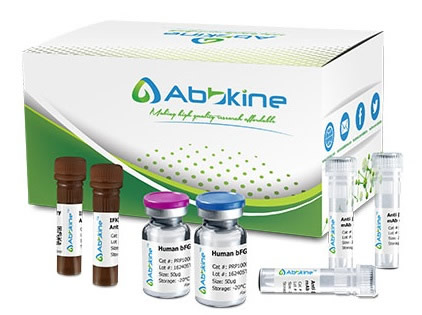IFN beta elicits a markedly higher antiproliferation response in some cell types such as, embryonal carcinoma, melanoma and melanocytes than do IFN alphas. Higher potency of IFN beta in treatment of multiple sclerosis and certain cancers has been observed. Type I IFNs signal through binding to a common cell surface receptor. Two chains of the receptor, IFNAR1 and IFNAR2, have been identified. Both chains are necessary for function and in the absence of either there is neither high affinity binding nor biological activity. The intracellular portions of the receptor subunits are bound by tyrosine kinases, Jak1 and Tyk2, members of the Janus kinase family. Upon ligand binding these kinases are activated and phosphorylate members of the STAT family of transcription factors, as well as IFNAR1 and 2.
Chicken Interferon β (IFN-β1/IFNB) ELISA Kit employs a two-site sandwich ELISA to quantitate IFNB1 in samples. An antibody specific for IFNB1 has been pre-coated onto a microplate. Standards and samples are pipetted into the wells and anyIFNB1 present is bound by the immobilized antibody. After removing any unbound substances, a biotin-conjugated antibody specific for IFNB1 is added to the wells. After washing, Streptavidin conjugated Horseradish Peroxidase (HRP) is added to the wells. Following a wash to remove any unbound avidin-enzyme reagent, a substrate solution is added to the wells and color develops in proportion to the amount of IFNB1 bound in the initial step. The color development is stopped and the intensity of the color is measured.
Chicken Interferon β (IFN-β1/IFNB) ELISA Kit listed herein is for research use only and is not intended for use in human or clinical diagnosis. Suggested applications of our products are not recommendations to use our products in violation of any patent or as a license. We cannot be responsible for patent infringements or other violations that may occur with the use of this product.
bio-equip.cn




